Are you considering switching your cat to a raw food diet? It’s a popular trend among pet owners, but before making the switch, it’s important to understand the pros and cons.
Raw food diets for cats involve feeding them uncooked meat, bones, and organs, as well as vegetables and supplements. While some cats thrive on this diet, others may not do well with it.
In this article, we’ll explore the benefits and drawbacks of a raw food diet for cats, as well as other feeding options to help you make an informed decision about what’s best for your furry friend. After all, your cat’s health and well-being should always be a top priority.
Key Takeaways
– Raw food diet for cats can offer numerous health benefits, including improved digestion, stronger immune system, and better dental health.
– The diet requires proper handling and preparation for safety, as well as nutritional balance with high protein and other nutrients.
– Consultation with a veterinarian or animal nutritionist is recommended before switching to a raw food diet for cats.
– Potential risks and costs must be carefully considered before making the decision, as harmful bacteria and nutritional imbalances are possible risks.
Understanding the Raw Food Diet for Cats
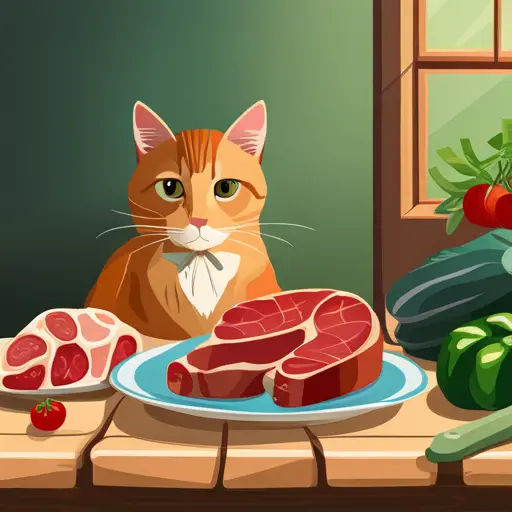
You might be wondering, “What exactly is the raw food diet for cats?”Well, it’s a diet that consists of uncooked meat, bones, and organs.
The idea is to mimic a cat’s natural prey and provide them with all the necessary nutrients they need. However, it’s important to note that raw food safety is a concern, as raw meat can contain harmful bacteria that could make your cat sick.
To ensure the safety of your cat, it’s important to handle and prepare raw meat properly. Another important consideration when it comes to the raw food diet for cats is nutritional balance.
While it’s true that cats are obligate carnivores and require a diet high in protein, they also need a balance of other nutrients such as vitamins and minerals. It’s important to consult with a veterinarian or animal nutritionist to ensure that your cat is receiving all the necessary nutrients on a raw food diet.
Additionally, it’s important to monitor your cat’s weight, as overfeeding can lead to obesity and other health problems.
Pros of a Raw Food Diet for Cats
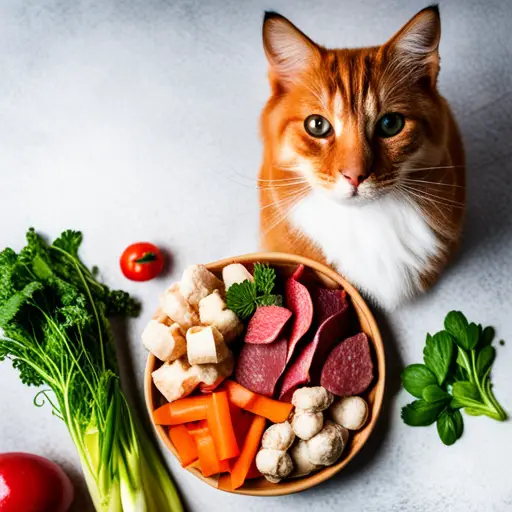
Imagine your feline companion feeling energized, maintaining a healthy weight, and enjoying a shiny coat due to a natural and nutrient-rich meal plan. This is exactly what the raw food diet for cats promises to deliver.
Here are some nutritional benefits and health advantages of this diet that can make a difference in your cat’s life:
1. Improved digestion: Raw food is easier to digest than processed food, which can help your cat absorb more nutrients and reduce digestive issues.
2. Stronger immune system: A raw food diet is rich in antioxidants, vitamins, and minerals that can boost your cat’s immune system and help prevent illnesses.
3. Better dental health: Raw food requires more chewing, which can help clean your cat’s teeth and prevent dental problems.
By switching to a raw food diet, you can give your cat the best shot at a long and healthy life. With a little research and guidance from your vet, you can transition your cat to a raw food diet that’s balanced and tailored to their specific needs.
Cons of a Raw Food Diet for Cats
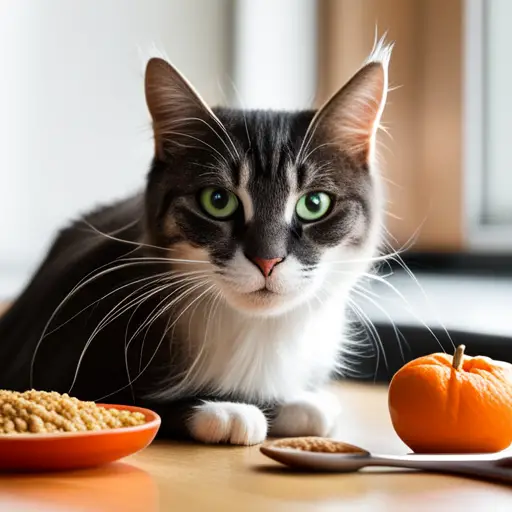
Feeding your feline friend a diet consisting solely of uncooked meat may lead to potential health risks. Raw meat can contain harmful bacteria such as Salmonella and E. coli, which can cause serious illnesses in cats. Even if the meat is of high quality, there is still a risk of contamination during handling and storage. This risk increases if the meat is not properly prepared or stored.
Another potential risk of a raw food diet for cats is nutritional imbalances. While raw meat may provide the necessary protein, it may lack other essential nutrients such as vitamins and minerals. Moreover, cats may not be able to digest certain components of raw meat, such as bones and connective tissue, which can lead to digestive issues.
Therefore, it’s important to consult with a veterinarian or a pet nutritionist before switching to a raw food diet to ensure that your cat is receiving a balanced and complete diet.
Other Feeding Options for Cats
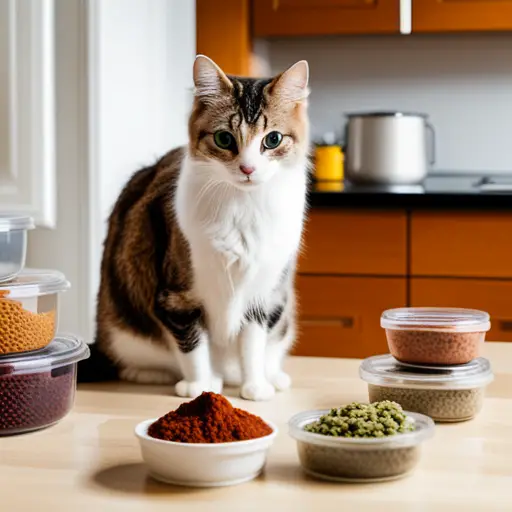
If you’re considering other feeding options for your cat, there are a few key points to consider. Traditional dry and wet food can be convenient and affordable, but some brands may contain fillers or preservatives.
Home-cooked meals offer more control over ingredients, but require more time and effort.
Combination diets, incorporating both commercial and homemade foods, can offer a balance of convenience and nutrition.
Traditional Dry and Wet Food
Typically, pet owners opt for traditional dry or wet food for their cats, which can be found in most grocery stores. These options offer convenience and affordability. However, it’s important to consider the benefits and risks of each type before making a decision.
Here are some things to keep in mind when it comes to traditional dry and wet food options for your cat:
– Dry food can help clean your cat’s teeth, but it can also lead to dehydration and urinary tract problems.
– Wet food provides more moisture, which can help prevent these health issues, but it can also be more expensive.
– Look for high-quality ingredients in both types of food to ensure your cat is getting proper nutrition.
– Consider your cat’s age and health when choosing between dry and wet food.
– It’s okay to mix and match, or even feed a combination of both types, to give your cat variety in their diet.
Remember, every cat is unique and may have different dietary needs. Consult with your veterinarian to determine the best feeding plan for your furry friend.
Home-Cooked Meals
Now that you’ve learned about traditional dry and wet food, let’s take a look at another option: home-cooked meals. While more time-consuming, this method allows you to have complete control over what ingredients your cat is consuming. Plus, it can be a fun bonding experience to cook for your furry friend!
Before diving into home-cooked meals, it’s important to consider the cost comparison and nutritional requirements. While it may seem cheaper to cook for your cat, the cost of quality ingredients can add up quickly. It’s crucial to ensure that your cat is getting all the necessary nutrients in their meals, so consulting with a veterinarian or animal nutritionist is recommended. Additionally, some ingredients that are safe for humans can be toxic to cats, so it’s important to do thorough research before feeding them any homemade meals. With the right guidance and effort, home-cooked meals can be a great way to provide your cat with a well-balanced and personalized diet.
| PROS | CONS | |
|---|---|---|
| Complete control over ingredients | Time-consuming | |
| Can be a fun bonding experience | Cost of quality ingredients can add up | |
| Personalized diet | Nutritional requirements must be carefully monitored | |
| Ingredients must be researched for safety | May lead to better health outcomes | Requires discipline and commitment |
Combination Diets
Combining different types of meals can create a diverse and exciting eating experience for your feline friend. Supplementing kibble with homemade recipes can give your cat a well-rounded diet that includes all the necessary nutrients. Here are four reasons why you should consider a combination diet for your cat:
1. Variety: Cats can get bored with eating the same food every day. Mixing things up with different types of meals can keep them interested in their food and prevent them from becoming picky eaters.
2. Nutritional balance: Kibble alone may not provide all the essential nutrients that your cat needs. By supplementing it with homemade recipes, you can ensure that your cat is getting a balanced diet that includes all the necessary vitamins and minerals.
3. Health benefits: Homemade recipes can be tailored to your cat’s specific needs, such as weight management or digestive issues. This can help improve your cat’s overall health and well-being.
4. Bonding: Preparing homemade meals for your cat can be a fun and rewarding experience that strengthens the bond between you and your furry friend. It also shows them that you care about their health and happiness.
Making the Decision for Your Cat
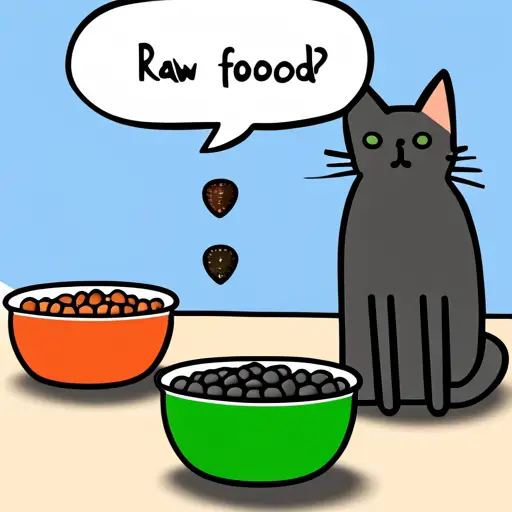
You need to weigh the pros and cons before jumping into a raw food diet for your cat, like a sailor assessing the winds before setting sail on a new journey. On one hand, a raw food diet can provide numerous health benefits for your feline friend. Raw food is packed with nutrients and enzymes that can help improve their overall health and well-being. Plus, a raw food diet can help prevent certain health issues such as obesity, diabetes, and dental problems.
On the other hand, a raw food diet may not be suitable for all cats. There are cost considerations to take into account, as raw food can be more expensive than traditional cat food. Additionally, there are certain health risks associated with raw food such as bacterial contamination and nutrient imbalances. Ultimately, the decision to switch to a raw food diet for your cat should be made after careful consideration and consultation with your veterinarian. To help you make an informed decision, here is a table outlining the pros and cons of a raw food diet for cats:
| Pros | Cons |
|---|---|
| Packed with nutrients and enzymes | More expensive than traditional cat food |
| Can improve overall health and well-being | Health risks such as bacterial contamination and nutrient imbalances |
| Can prevent certain health issues | May not be suitable for all cats |
Take the time to evaluate the pros and cons of a raw food diet for your cat. While it may seem like a good idea to switch to a raw food diet for your furry friend, it’s important to consider the potential risks and costs associated with it. Ultimately, the decision should be made with your cat’s health and well-being in mind.
Conclusion
So, is the raw food diet right for your cat? It ultimately depends on your specific cat and lifestyle.
While a raw food diet can provide many benefits such as improved digestion and a shinier coat, it also comes with its own set of risks such as bacterial contamination and nutritional imbalances.
It’s important to do your research and consult with a veterinarian before making any drastic changes to your cat’s diet.
Overall, choosing the right feeding option for your cat is a personal decision that requires careful consideration. As you weigh the pros and cons of different diets, remember to prioritize your cat’s health and well-being above all else.
Whether you choose a raw food diet, a commercial diet, or a homemade diet, make sure it aligns with your cat’s individual needs and preferences. After all, a happy and healthy cat is a beautiful sight to behold.
